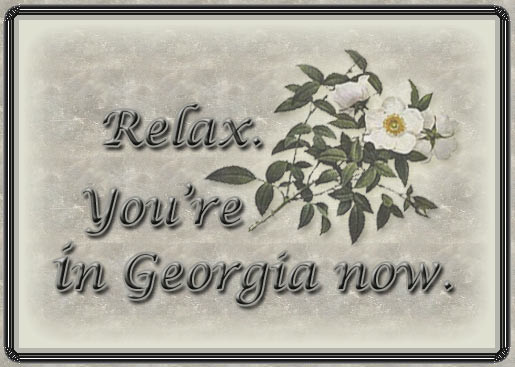

The State of Georgia is a combination of big cities, small towns, mountains and beaches, and a wealth of historic sites that feature the depth and breadth of Southern living.

Although I'm not a native of Georgia, I've lived here most of my life and have grown to love this part of the South and will always consider it my home. The state of Georgia has 5 distinct regions so come along as we start at the top and work our way down.

Mountains
This is the part of Georgia where I make my home now, so naturally it's my favorite part of the State. Rich with an abundance of natural beauty, North Georgia has gone through a tremendous poulation growth in the last 20 years and it's no wonder. In Georgia’s mountains you’ll find dramatic vistas, wild whitewater, and unspoiled forests (so please keep this part a secret;).
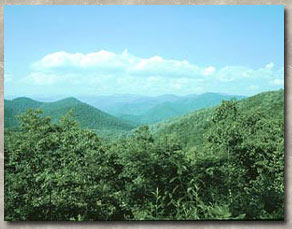
A section of the Blue Ridge is found in northeastern Georgia north of the Piedmont. These mountains are forested with hardwoods and pine softwoods. Much of North Georgia is encompassed by the Chattahooche National Forest with elevations ranging from 1,000 to 5,000 feet. Located in the mountains is the southern most point of the 2,144 Appalachian Trail on the way to its terminus in Maine. Brasstown Bald Mountain is Georgia's highest at (4,780feet)
Alpine Helen is the most popular destination in North Georgia. The rugged beauty of this high mountain watershed, known today as the Helen Valley, attracts hundreds of thousand people to events such as Oktoberfest and the Alpine Lights. The Chattahoochee River begins as a spring above Helen in the fittingly name "Chattahoochee Gap," little more than a trickle of water at 3200 feet. Over the first 100 miles the river falls almost 2400 feet, forms a major Southeast lake (Lanier) and provides water for millions of Georgians.

Near Calhoun is the New Echota Historic Site where Cherokee Indians modeled their new nation based on the United States Government culminating in the "Trail of Tears" to Oklahoma. In Cartersville there is a very unique historical Indian State Park named the Etowah Indian Mounds.
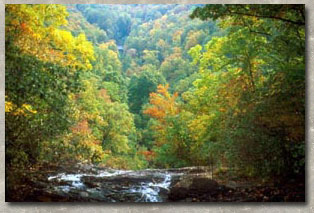
In this area of the State there are many bold waterfalls. Amicalola Falls (Cherokee meaning "tumbling waters"), which plunges 729 feet, is the highest waterfall in the Eastern United States. Georgia has over 4,000 miles of trout streams with the majority of the streams in the mountains of North Georgia. The small mountain town of Dahlonega, a Cherokee word meaning "precious yellow," is the site of the country's first major gold rush where you can still pan for gold.

Historic South
Here you'll find music legends, year-round golf & historic sites. Stretching from the rolling foothills of the Blue Ridge Mountains in the north to the edge of the Okefenokee in the south, and from the wiregrass country in the west to the white sands on the edge of the coastal plain, this is the heart of Georgia. A sweet onion known around the globe, artists and performers who became legends, and inventions that changed the world are what you can expect from the land of the Historic South.
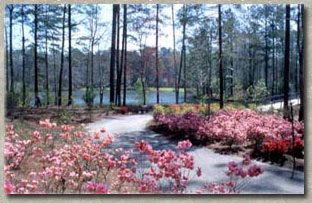
The southwest area of Georgia is comprised of meandering rivers. Callaway Gardens with 14,000 acres of gardens, woodlands and lakes and over 700 colorful varieties of Azaleas is a favorite destination.
Columbus is the largest city in historic Georgia, situated on the Cattachoochee River at the foot of a series of falls. Columbus used its water supply to become an important manufacturing center for arms during the Civil War. Today it is home to Fort Benning, the only U.S. Army infantry training center.
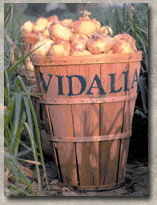
Grown properly only in a small pocket of south Georgia, the Vidalia onion matures into unsurpassed sweetness in the spring. In one of nature's most delicious mysteries, the granex seed, which produces a hot onion elsewhere, grows into an onion one "can eat like an apple" in the fields around Vidalia and Glennville. This area is also reknowned for pecans.

Atlanta Metro
Having spent a good portion of my youth living around Atlanta, alot of good memories were brought back while researching this part of Georgia.
From a virtually uninhabited railroad terminus in 1837 to a sprawling metropolis of over four million people today, metro Atlanta has the vibrancy of the world’s great urban centers combined with the Southern charm of small town centers. Here you’ll find historic sites from the Civil War through the Civil Rights era, as well as world-class shopping, entertainment, and nightlife.
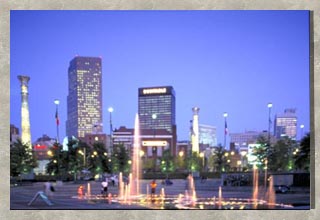
Atlanta was burnt during the Civil War, a part of history that was later written about by Margaret Mitchell; her book Gone With The Wind became a legend and was later turned into an epic Hollywood movie.
Georgia is home of the Atlanta Brave Baseball, Falcons Football and Atlanta Thrashers Hockey teams. Atlanta has emerged as a banking center and is world headquarters for Fortune 500 companies such as Delta Airlines, Coca Cola, Holiday Inn Worldwide and United Parcel Service. At The King Center you can view unique exhibits illustrating the life and teachings of Martin Luther King and visit the King Center’s Library, archives, and his final resting place.

In the hub of convention business in the capital city you'll find the Centennial Olympic Park, Georgia’s World Congress Center as well as the World of Coca-Cola, a 45,000-square-foot pavilion where the history of this favorite soft drink—past, present and future—is told through fascinating exhibits. After the tour, you can lunch at Underground Atlanta.
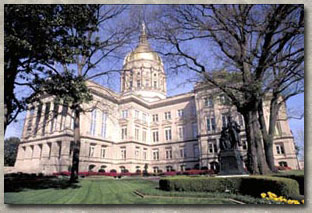
The Georgia State Capital was dedicated on July 4, 1889. The gold leaf on its dome, rising 237 feet above the city, was mined in nearby Dahlonega.
Am very proud to proclaim that we recently elected a new Republican Senator Saxby Chambliss, and Governor Sonny Perdue - the first Republican Governor since Reconstruction, and hope to take back Democrat Zell Miller's Senate seat in the next election!
Fernbank Museum of Natural History has an impressive dinosaur connection. This exceptional facility also has a delightful Star Gallery that provides an easy way to find stars in the evening sky with the help of a Fernbank astronomer and a fiber optic ceiling. Discovery: The Naturalist Center at Fernbank, is an educational facility equipped with laboratories, computers and a scanning electron microscope.
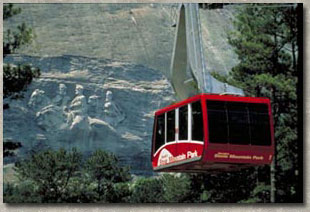
On 3,200 gorgeous acres just 16 miles east of downtown Atlanta, the stories of the South come to life at Stone Mountain Park. The mountain itself is the world's largest mass of exposed granite. The centerpiece of the Park -- and one of the true marvels of western engineering -- is found on the mountain's North side, where you'll see the world's largest high relief carving, depicting three heroes of the American Confederacy, Robert E. Lee, Jefferson Davis and Stonewall Jackson.

Classic South
Farming, Folklife & Folklore. Off the main highway and into the countryside, the land spreads out and the roads roll into small towns, each of which offers its own unique charms and intriguing history. You’ll discover an outdoor paradise, where the lakes teem with fish, the woodlands are alive with wildlife and the rivers flow steadily across the landscape.

Take in Georgia's Antebellum Trail. Unspoiled lakes and forests surround charming, white-columned mansions in city squares. Three of these classic antebellum towns are Washington, Madison and Milledgeville. The area also encompasses Athens,"The Classic City" home to the University of Georgia, and Augusta, well known for the world's most prestigious golf tournament, "The Masters". As the state's geographic center, Macon, founded in 1823, has more than 150,000 flowering cherry trees, resplendent with blossoms during the annual March festival. Its antebellum and Victorian homes are among the state's best preserved. Macon is home to the Georgia Music Hall of Fame whose honorees include Ray Charles, James Brown, The Allman Brothers Band, Little Richard and Chet Atkins.
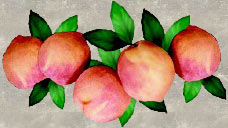
Many different types of crops and produce are grown in this area of the state. Georgia grown peaches are recognized for their superior flavor, texture, appearance and nutritious qualities that promote a healthy, balanced diet. Georgia is known as the "Peach State" because of the growers' reputation for producing the highest quality fruit. The peach became the official state fruit in 1995.
Farther south is Milledgeville, the former capital of Georgia from 1803 - 1868. General Sherman burned government buildings and documents, but essentially left the antebellum homes in tact during the civil war. The locals refer to the town as "The Antebellum Capital of Georgia." It is the only town besides Washington DC to be designed as a capital.

Coast, Barrier Islands
Here you’ll find Savannah and its historic district, dotted with parks and lined with moss-covered trees. St. Simons Island, Sea Island, and Jekyll Island have miles upon miles of protected seashore with endless white sand beaches and deserted barrier islands perfect for exploring.
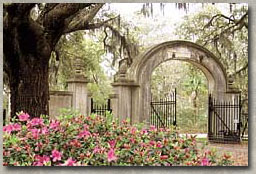
The four designated "Golden Isles" are St. Simons, Little St. Simons (not accessible by vehicle) - Sea Island and Jekyll Island. Although some "Golden Isles" have been developed, other islands, such as Cumberland and Little St.Simons still linger in the past. Some islands are accessible only by boat. Driving along U.S. 17 you pass broad sandy beaches, creeks, rivers and ruins of antebellum plantations.
In the 1500s, the Spanish arrived in this area, their soldiers seeking gold, and their missionaries seeking religious converts among the Native Americans. In 1736, General James Oglethorpe founded Fort Frederica on St. Simons Island. Six years later, Oglethorpes troops defeated insurgent Spanish at The Battle of Bloody Marsh and helped determine the course of colonial history.
Later, the antebellum era flourished as sea island cotton became king and sprawling plantations operated all along the Georgia coast until late 1800.

The Okefenokee Swamp, one of America’s most fascinating natural areas, is the largest Swamp in North America. Approximately 700 square miles, located in the southeast corner of Georgia, Okefenokee is rich with wildlife. The vast expanse of forest and wetlands is now one of the best-preserved freshwater sanctuaries in the country. Alligator's glide silently through Okefenokee Swamp.
The swamp contains numerous islands and lakes, along with vast areas of non-forested terrain. Prairies cover about 60,000 acres of the swamp. The prairies harbor a variety of wading birds: herons, egrets, ibises, cranes and bitterns.
Hope you have enjoyed your cyber tour through Georgia.
Most of the information above was taken from several Georgia Tourism sites.

|
|
|
|
|
|
|


